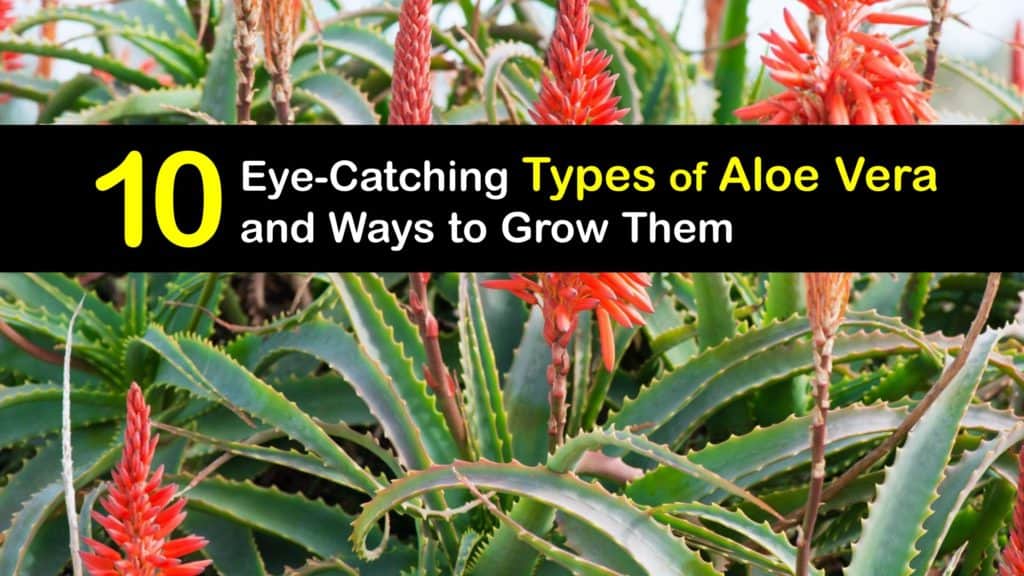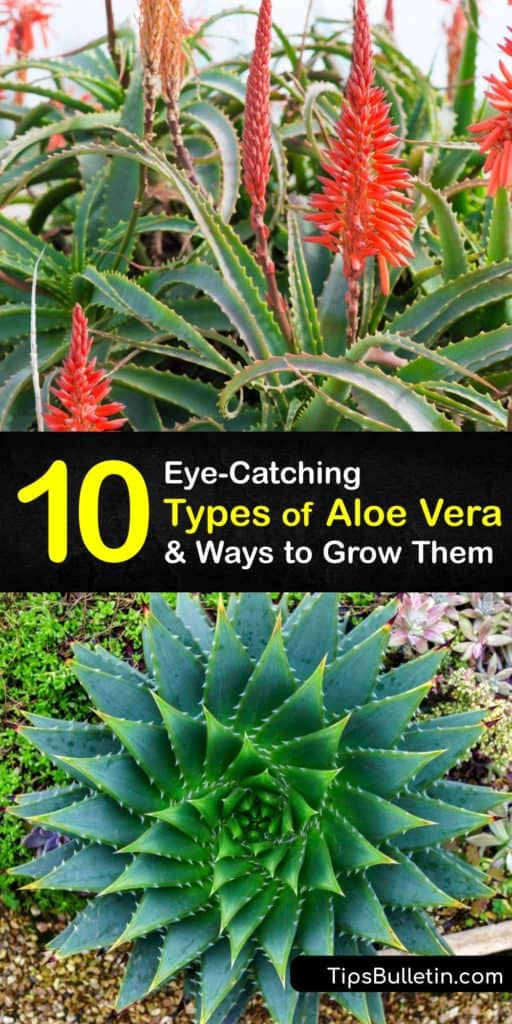Aloe is a succulent plant originating from the Arabian Peninsula, now considered an invasive species across the world. Of more than 500 species of aloe, there are various types of aloe vera used by humans as commercial products and decorative houseplants. Many common types of aloe grow in South Africa, where they thrive in ideal weather conditions.
Different types of aloe vera are cultivated for medicinal uses, while many harvest true aloe vera for pharmaceutical purposes and its health benefits. People use aloe vera gel to treat skin conditions like sunburn and create beverages like aloe vera juice.
Aloe vera varieties serve different purposes depending on why you grow or harvest them. Some common types of aloe vera attract birds, while others draw beneficial insects like bees. When added to your garden, aloe vera plants add color and serve as border plants.

Aloe Vera Types
Many adore aloe plants for their medical or cosmetic usage and as decorative houseplants or ornamental additions to their garden. While most aloe plants are green, some have leaves that change colors based on environmental factors and produce colorful flowers.
Cape Aloe
Cape aloe is a flowering plant native to South Africa in the family Asphodelaceae. After harvesting Cape aloe, its juice makes bitter aloes like laxatives.
Also known as Aloe ferox or red aloe, this succulent forms a blue-green rosette with brown spines along the edge of its leaves. Cape aloe produces bright orange flowers with darker orange stamens that come from the mouth of the plant.
The best soil for aloe vera of the Aloe ferox variety is well-draining soil in full sun. Like all succulents, Aloe ferox is drought-tolerant and grows well in garden beds, rock gardens, and gardens for other succulents.
Aloe Maculata – Soap Aloe
This type of aloe plant is sometimes referred to as soap aloe due to the soapy lather its gel creates in water. Locals use this lather in its native area of South Africa.
Maculata grows small rosettes of thick leaves with white spots that produce sharp teeth along the edges. While growing in full sun, the plant is light red but turns blue-green while growing in partial shade—the plant blossoms orange flowers from winter to spring that attract bees and hummingbirds.

Among aloe vera types, Maculata is versatile in how it grows. Maculata grows in sandy or gravelly soil that is either moist or dry. Maculata is also salt and drought-tolerant, perfect for gardens near the sea.
The Popular Barbados Aloe
Also known as Aloe barbadensis, this plant is known for the medicinal value of its leaves. It grows tall in rosette clumps with narrow green leaves with sap inside. Although not clinically backed by evidence, many use the juice of this plant in various cosmetic and skincare products.
Barbadensis is a low maintenance plant as it has low water requirements that requires moderate watering during the year and even less during winter months. To promote growth through propagation, gardeners often divide dense clumps every few years.
Aloe Arborescens
Known for its colorful flowers, this type of aloe plant is recognized by its branching stems where rosettes grow. Each rosette grows sword-shaped gray-green leaves.
Many believe aloe arborescens helps with cell proliferation when tumors are present in the body. Although modern studies support this, speak with your healthcare provider before including aloe in any treatment plan.
Spiral Aloe – A Plant of Beauty
Among the types of aloe plants, few are as visually stunning as spiral aloe. Also known as Aloe polyphylla, spiral aloe is a compact succulent known for its leaves that grow in a spiral pattern.
The gray-green leaves form a tight rosette, developing into a spiral that grows clockwise or counterclockwise. This plant rarely flowers, but if it blooms, there are usually red flowers that grow from a branching spike above the green leaves.
This succulent grows well in most soils and has low water needs. Like other succulents, spiral aloe plants do not require much water during their dormant period. Feed the plant with a balanced fertilizer up to three times during the spring and summer months during the growing season.
Torch Plant
Sometimes known as Lace aloe or Aloe aristata, this succulent plant produces fleshy leaves that grow in an incurved pattern with white spots. Capable of growing in the shade or full sun, this plant changes from pale green to a rich dark green color in full sun.
The torch plant grows a tubular mass of orange-red flowers above its green foliage, up to 20 inches high during the winter months. This aloe is a low-growing plant perfect for growing in containers due to the formation of its rosettes.
Aloe Brevifolia or Short Leaf Aloe
Aloe brevifolia is sometimes referred to as short-leaf aloe due to its growing pattern of forming tight rosettes of triangular leaves. These leaves grow pale blue in the shade but take on a yellow to pink gradient when growing in full sun.
This plant develops orange tubular flowers above its multi-color foliage in late spring. A compact plant, this succulent grows up to two feet, making it ideal for container growing or as a groundcover plant for small areas.
Arabian Aloe
Arabian aloe is a succulent plant that grows thick leaves that arch outward from its base. In partial shade, these leaves are blue-green with red teeth along their edges. If this plant grows in full sun, the leaves take on a purple color that grows more intense in the winter months.
Also known as Aloe rubroviolacea, the fleshy leaves of this aloe plant grow from thick stems that allow the plant to grow and sprawl outward. During the winter season, red flowers form along with spires above the plant’s foliage.
Cape Speckled Aloe Produces Gorgeous Flowers
Known as one of the best flowering aloe vera plants in South Africa, Cake Speckled aloe (Aloe microstigma) grows small clumps of rosettes with blue-green leaves. When experiencing environmental stress, this plant’s leaves turn from blue-green to reddish-brown.
Common types of stress for succulent plants include changes in sun exposure, temperature shifts when the seasons are changing, and changes in the water level in the soil. Some succulents also grow taller due to growing in low light conditions.
The leaves of this plant have white spots that stand out against the reddish leaves and reddish teeth along the edge of the leaves. This plant produces unbranched red-yellow flowers that are said to resemble candle flames after blooming.
Aloiampelos Ciliaris
Formerly known as Aloe ciliaris, the common climbing aloe is a thin succulent plant from South Africa. One of the defining features of Aloe ciliaris is the white teeth that circle the stem at the base of the leaves and along the edges of the leaves like other aloe plants.
The plant’s fleshy leaves are recurved, which aid the plant in anchoring its stem as it climbs in its natural environment or along support structures in the garden. Aloiampelos ciliaris is the fastest-growing of all aloe plants.
If the plant grows in an area without any support for its leaves to grab, the plant grows into a small shrub instead. This aloe produces red flowers during the winter months, usually November through April.
Growing Varieties of Aloe Vera
Growing aloe vera plants is a task anyone can undertake due to the ease at which succulent plants grow. It has low maintenance requirements, and it’s just as easy to grow an aloe vera indoor plant as it is one outside, provided you have the climate for it. Succulent plants are similar to cacti in that they do well in drier conditions.
Many varieties of aloe vera plants propagate from seeds, like Spiral aloe and Aloe aristata. Planting aloe vera seed pods is just as easy as pups, it just takes a little longer. When growing succulents, start with a cactus potting soil mix or a regular potting soil mixed with perlite or building sand.
Caring for Aloe Plants
Because succulents enjoy drier conditions, overwatering is a concern when growing aloe plants. If you’re growing aloe in a pot, select a pot with good drainage holes to avoid standing water in your container.
Whether in the garden or a container, caring for an aloe plant the right way is important to ensure that it thrives. The soil for your aloe plant should be dry before watering. Thoroughly drench your soil and allow it to drain if the plant is in a container. Leaving succulents to sit in standing water or watering them too often are common reasons aloe plants die.
Many varieties of aloe vera plants enjoy a liquid fertilizer used a few times during their active season; however, this is not required. If you want to feed your plant, use a water-based phosphorus fertilizer up to three times during the spring.
Note: Aloe does not tolerate frost, so it only grows outdoors in a few zones (8-11) and needs to be moved indoors during the winter months.
Dealing with Common Types of Aloe Vera Pests
While growing indoors, your biggest concern should be root rot, but while your aloe enjoys time outdoors, various pests may target your plant. The most common problems for aloe plants involve sucking insects that feed on the sap inside the plant.
Aphids, specifically Aloephagus myersi, feed on aloe plants to get the sap that forms inside the leaves. These insects are small and feed on the inner curl of plant leaves. Aphids leave honeydew on the leaves they feed on, leading to sooty mold.
Gall mites infect plants with a disease that causes deformities on plant flowers and stems. For stemless succulents, this affects their leaves, creating tumorous-looking growths. To deal with this disease, prune affected leaves, but in the case of a severe infection, dispose of the plant.
Snout weevils are small insects that use a proboscis to suck the sap out of a plant. These pests damage plants like aphids do, but their threat to aloe is more significant because of how much juice they draw out in a short period.
These pests lay eggs after feeding that hatch and burrow into the stem of the aloe plant, rotting it from the inside. Luckily weevils are easy to spot and remove from your plant, and brushing their eggs off into a bucket of soapy water saves your aloe plant from dying to an infestation. Make a quick soap spray for aphids and other small insects to kill them.
Combine the ingredients into a 16-ounce bottle to spray evenly across your succulent plants at the first sign of pest activity. Soap is effective at dissolving the exoskeleton of insects, causing them to lose water quickly, while vegetable oil helps the spray stick to plants.
Whether you want to grow a source of aloe vera gel at home or want to add color to your garden space, growing aloe plants is a fun project. With minimal gardening requirements and long lifespans, aloe plants are perfect for your home garden.

If our article on types of aloe vera plants was helpful to you, please share our guide on different aloe vera types with your friends on Facebook and Pinterest.